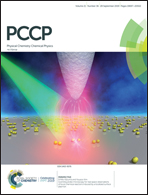A noncovalent interaction insight onto the concerted metallation deprotonation mechanism†
Abstract
The CMD/AMLA mechanisms of cyclopalladation and the parent fictitious but challenging cyclonickelation of N,N-dimethylbenzylamine have been investigated by joint DFT-D and DLPNO-CCSD(T) methods assisted by QTAIM-based noncovalent interaction plots (NCI plots) and interacting quantum atoms (IQA) analyses, and the local energy decomposition (LED) procedure. Bader charges, NCI plots, IQA and the LED analyses clearly suggest that coulombic interactions play an important role and somewhat govern the whole process that is sensitive to the charge borne by the metal centre. It is found that replacement of acetate by acetamidate used as a ligand and a base significantly lowers the barrier to the formation of the key agostic intermediate. The latter shows a peculiar polarization by its immediate ligand environment where a significant electrostatic CH⋯O interaction with the neighboring carboxylato ligand competes with the strong propensity of the latter to bind the metal center, which is stronger in the agostic intermediate when the carboxylato ligand is the acetate and when the metal is Ni. It is also shown that the hereby idealized cyclonickelation is disfavored as compared to cyclopalladation owing to enhanced electrostatic repulsion in almost all stages of the CMD mechanism.

- This article is part of the themed collection: 1st International Conference on Noncovalent Interactions


 Please wait while we load your content...
Please wait while we load your content...